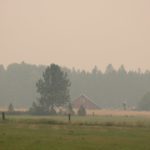Smoke Pollution
Posted: September 17, 2017Source: The Forest Blog by Russ Vaagen
In Northeast Washington on August 1st, 2017 we woke up to smoke from wildfires. It wasn’t as thick here as it was in other areas, but it was bad at varying levels throughout the month. Now that September has started it feels like August was clear. The smoke is so thick that visibility is impaired within 100 yards and nearly nonexistent within a mile. Your eyes burn and you find yourself continually coughing. There’s no escape. Some people have been living with it throughout the west like this every day for well over a month. This is smoke pollution and it’s likely to be a problem for years.
Carbon Source?

When you drive around areas that are supposed to be places of natural beauty and splendor, and it feels as though you’ve been dropped into Beijing it makes you wonder what it all means. This is supposed to be the part of the world that is capturing carbon dioxide and pumping out oxygen. It sure seems like it’s become the other way around over the last 10 years, getting progressively worse.
These forests are becoming a wasteland. How long will it take before the trees start to grow back and produce oxygen? Many of these forests are burning hotter than ever. I have personally seen where these forests burn so hot that it burns entire root systems out. It scorches the earth to the point where recovery is a long and difficult process.
So here we are trying to do everything we can to reduce our carbon footprint, but we’re turning our back on the very forests that are the lungs of the earth. We need to manage these forests to save them. We need to put the science in high gear and do what needs to be done. That means thinning out vast acreages of forests in a way the provides them a chance to withstand fires.
Thick forests
Thick forests lead to thick smoke. When the number of trees and the amount of brush in the forest reach many times the number that was there naturally, they not only burn hotter but create greater volumes of smoke and pollution. Let’s say that there is three times more burnable material in the forest in 2017 than there was in 1977. This means that in 2017 every acre of fire equals at least three times the amount of smoke 40 years ago. If the number of acres burned in 2017 reaches 10 million acres in the United States, that means that it could be the same amount of smoke and carbon pollution of 30 million acres of burn in 1977.
Based on data collected by Georgia Tech, these new fires with more fuel are creating more health complications and pollution. This NPR story tells the story pretty well. Their findings were that the hotter fires we have today, fed by massive amounts of dry fuel in the forest are much worse for humans, animals, and the environment. This new information should lead even more urgency to a solution. Fires are going to happen, but do we need to leave this much debris in the woods?
The tree species that are native to fire-prone forests are naturally wildfire resistant with thick bark and limbs high off the ground. They need spacing that allows them to survive these intermittent fires. In today’s public forests those trees are invisible because of a sea of small trees and brush. When these fires start we lose all those old growth trees. We can save them by removing the other trees that have enough value to pay for the effort to get them out.
A better way
What a novel concept. We can build businesses that thrive from the by-product of restoring our national forests. Sawmill technology has moved to efficiently process small and medium sized logs, not the big old growth logs of the past. We need to build businesses that are right-sized to the needs of the problem. We can estimate the need and build the facilities to use the trees that need to be removed. Why aren’t we doing this?
We’re not doing it because the Forest Service and the Bureau of Land Management are effectively paralyzed. Some of that paralysis is from lawsuits from environmental interests, and some of it is built into their culture. A risk-averse culture that doesn’t think it’s safe to try new things or make significant changes. Most of the conservation groups in the West agree that management is necessary. Still, there are some that think any management is too much. They cannot see the forest for the trees. We cannot appease them, and we shouldn’t try.
We need to quickly mobilize and get with key leaders from conservation groups and find the issues that lead to consensus. Once we do that, we should give those findings to Congress so they can draft legislation that works. We don’t need something that will have conservation groups wanting to turn the tide back their way once they get political support.
We need to be proactive about this. The forest industry and the conservation movement need to realize that we have common goals. Once we realize that we can support our collective interests, we can see real change that benefits us all.

